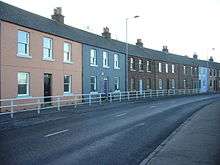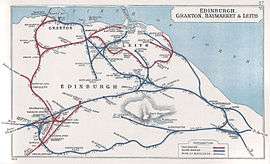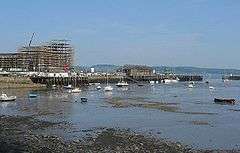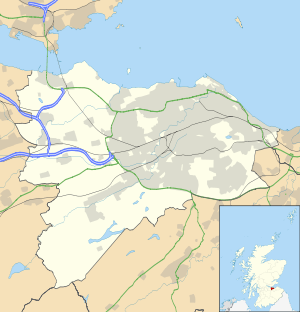Granton, Edinburgh
Coordinates: 55°58′34″N 3°13′44″W / 55.976°N 3.229°W
Granton is a district in the north of Edinburgh, Scotland. Granton forms part of Edinburgh's waterfront along the Firth of Forth and is, historically, an industrial area having a large harbour. Granton is part of Edinburgh's large scale waterfront regeneration programme.
Name
Granton first appears on maps in the 17th century relating to the now demolished Granton Castle.[1] The name also appears in Granton Burn, which now runs through Caroline Park down to what was Granton Beach. The name is presumed to come from Grant's Town or Grant's Dun (hill).
Granton Castle
The castle is first documented in 1479, as a building owned by John Melville of Carnbee, Fife. It stood to the north-west of the current mansion, Caroline Park. On John's death it passed to his son, also John Melville, who was one of the many Scottish nobility killed at the Battle of Flodden. In 1592 it was sold by the Melville family to John Russell but by 1619 was acquired by Sir Thomas Hope, the Lord Advocate, who greatly altered and extended the castle. On his death it passed to his son, Sir John Hope, Lord Craighall.[2]
The building fell derelict by the 18th century. At the end of the 19th century the architectural historians MacGibbon and Ross did a survey and created scale drawings of the remnants. This showed a standard L-plan Scottish tower house with a courtyard to the north side. This was accessed by a gateway on the west side, on the outer side of which was a loupin stane, a set of steps to aid a person to mount a horse.
In 1928 a quarrying firm, Bain and Brown, bought the site to excavate the rock outcrop beneath the castle. The majority of the castle was lost due to this exercise. The exercise itself was largely redundant as the steeply angled rock bed quickly meant excavation became too deep to be economic. Now only small fragments of the castle remain.
Granton Harbour



In 1834 Edinburgh debated the need for a larger harbour. James Walker in his capacity as President of the Institute of Civil Engineers oversaw a committee, also including Admiral David Milne, to choose between three options: an extension to the existing Leith Docks; a new harbour at Trinity or a new harbour at Granton. The initial bid for Trinity did not receive parliamentary consent and in 1836 a second Bill promoting Granton was agreed. It received Royal Assent on 21 April 1837.[3]
Construction began in June 1837 and the initial central pier was opened on 28 June 1838, coinciding with the coronation of Queen Victoria.The entire project was funded by the 5th Duke of Buccleuch. The original project included a central pier named the Victoria Jetty and a road running eastwards to Leith. The young Queen Victoria landed at the pier on RY Royal George on 1 September 1842 on her first official visit to Edinburgh as queen. In 1843/44 the pier was extended in length to a total of 1700 feet (around 500m) this stage being completed in October 1844.[4]
Lighthouse engineer Robert Stevenson oversaw the later construction of the outer breakwaters, which were completed in 1863. Thereafter the Resident Engineer was John Howkins, followed by his son, also John Howkins.[5] The original concept to create two large wet docks on the landward side was abandoned as this proved impractical.[6]
Granton became a successful port for the export of coal, and import of esparto grass for making paper. The fishing fleet grew considerably, leading to the development of an ice house in the late 19th century, to the west of the harbour. There were some 80 fishing trawlers resident just before World War II. The first example of the fossil crustacean Waterstonella was found in the Granton shrimp beds by the keeper of geology at the Royal Scottish Museum, Dr. Charles Waterstone.[7][8] The foreshore area between Granton and Newhaven is a designated Site of Special Scientific Interest (SSSI) aimed at encouraging and preserving the resource of fossils in the area.
From 3 February 1850, the world's first ferry-train began operating between Granton and Burntisland, Fife.[9] The paddle-steamer Leviathan carried the trains, which formed the main link across the Forth until completion of the Forth Bridge in 1890. Passenger and car ferry services continued into the 1960s.
In 1884, John Murray set up the Marine Laboratory in Granton, the first of its kind in the United Kingdom. In 1894, this laboratory was moved to Millport, Isle of Cumbrae, on the Firth of Clyde, and became the University Marine Biological Station, Millport, the forerunner of today's Scottish Association for Marine Science at Dunstaffnage, near Oban, Argyll and Bute.[10]
Granton was the key base in Scotland of the Northern Lighthouse Board with their boats taking lighthouse keepers and their supplies to and from lighthouses around the coast of Scotland. Granton also became the base for pilots from 1920, guiding ships into the Firth of Forth, a service it still provides a base for today.
From 1942 to 1946, Granton harbour was home of shore-based minesweeping training establishment HMS Lochinvar. As the scale of the harbour restricted ship size, it became a site for scrapping former Royal Navy ships, including HMS Newport and HMS Hedingham Castle.[11]
Today two boat clubs jointly run the Edinburgh Marina: the Forth Corinthian Yacht Club and the Royal Forth Yacht Club.
Industry

Granton quarry to the west of the harbour was initially developed to provide stone to build the harbour. Later it provided stone for parts of Holyrood Palace, and for the statue of Lord Nelson on Nelson's Column in Trafalgar Square, London.
The oldest surviving car factory building in Britain is located in Granton. The Madelvic Motor Carriage Company works were built in 1898 for the manufacture of electric cars. Like the gasometers, the factory is also a listed building. However, approval has been granted for its demolition as part of wider redevelopment of the area.[12]
Granton Gasworks were formerly one of Edinburgh waterfront's most prominent landmarks, comprising three blue gasometers which were clearly visible from Fife. Two of the structures, built in the 1930s and 1970s, have now been demolished. The third structure remains, and is listed as an example of Victorian industrial architecture.
Development during World War Two included the construction of the works of Bruce Peebles (later Parsons Peebles), that made high voltage electrical equipment, including transformers for electricity power stations. The works burnt down in a huge fire in 1999, and is now part of the waterside redevelopment. The firm continues in business as Parsons Peebles Generation Limited, Wood Road, Royal Dockyard, Rosyth. Ferranti's factory on Ferry Road was built to make electronics for aircraft, including gyro-based gunsights for the Supermarine Spitfire.
Transport

Buses
Bus services are mainly provided by Lothian Buses. Buses that Terminate in Granton either stop at Granton Square or the Scottish Gas HQ, the Scottish Gas HQ journeys will have West Granton, Pilton or Muirhouse as their destination blinds
8 Muirhouse - Granton - Pilton - Canonmills - North Bridge - Newington - Moredun - Royal Infimary
14 Muirhouse - Granton - Pilton - Ferry Road - Elm Row - North Bridge - Newington - Prestonfield - Niddrie
16 Colinton - Oxgangs - Morningside - Tollcross - Princess Street - Leith - Newhaven - Granton - Muirhouse - Silverknowes
19 Granton - Pilton - Western General - West End - Princess Street - Meadowbank - Lochend - Portobello
24 West Granton - Muirhouse - Drylaw - Western General - Stockbridge - West End - The Meadows - Blackford - Royal Infirmary
32 Granton - Muirhouse - Davidson Mains - Drum Brae - Sighthill - Wester Hailes
38 West Granton - Western General - Craigleith - Ravelston - Murrayfield - Gorgie - Morningside - Blackford - Kings Building - Royal Infirmary
47/X37 Granton - Western General - West End - Lothian Road (47) Princess Street (X37) - Newington - Liberton - Straiton - Penicuik Ladywood (47) Penicuik Deanburn (X37)
N16 Torphin - Colinton - Oxgangs - Morningside - Tollcross - Princess Street - Leith - Newhaven - Granton - Muirhouse - Silverknowes
Railways
On development of the harbour, the Duke needed a railway connection to make a profit. He became an investor in the Edinburgh, Leith and Newhaven Railway, which in 1842 opened a line from Canal Street railway station, at right angles to the present Waverley station, Edinburgh, to Trinity Crescent near the Trinity Chain Pier. The line was extended in 1838 to Granton harbour, located on the middle pier. The junction in Edinburgh was too steep to be operated by locomotive, and so trains had to be worked by rope. By 1868, a new line was built from Waverley Station through Abbeyhill to Bonnington which ended rope working.

From 1846 to 1890, Burntisland railway station was part of the main East Coast railway line to Perth, Dundee and Aberdeen. In 1890 when the Forth Bridge opened, the long distance trains started using it and after that the line to Granton was just used by local passenger and goods trains. Passenger trains ran until 1926, when the tram and omnibus services became fully integrated. Goods services ran until 1986, when the lines were lifted.
In 1861 the Caledonian Railway opened a line to Granton from Dalry, providing goods service to Granton harbour. They agreed a contract to run passenger services to the new gas works from central Edinburgh. In 1864 the Caledonian built a line to Leith, with stations at Newhaven Road (near Trinity Academy), Granton Road, East Pilton, Craigleith, Murrayfield and Dalry Road running to Edinburgh Princes Street. One of the two connections between the Caledonian and the North British networks was on Granton Square. Passenger trains ran until 1962, and goods trains until 1968, when the lines were lifted.
The railway embankment, which separated Lower Granton road from the Forth was removed in the late 1980s.
Trams
In 1909, Leith Corporation ran trams from Leith to Granton. They were joined in 1923 by trams from the Edinburgh Corporation, resulting at one time in seven tram routes to the area: four from Leith via Lower Granton Road (services 2, 14, 16 and 17); three via Granton Road (services 8, 9 and 13). Trams to Granton were withdrawn in stages, from 1952 to 1956, and replaced by buses.
Proposed to be part of the new Edinburgh Trams systems on Line 1b, in April 2009, the City of Edinburgh Council announced the cancellation of Phase 1b of the project citing problems caused by the global recession, saving an estimated £75 million.[13] The decision meant that the construction of the line to Granton will not go ahead for the foreseeable future, although the possibility remains open that this phase may be revived in future, subject to available funds.[14]
Inter War to Present

From 1932 the Council developed Granton as a major housing scheme. Over 1500 houses, mainly tenements, were built from east to west, designed by City Architect Ebenezer MacRae and his team. The majority of these are still in use. Dr Charles Munro had developed a general practice in the area, and when he was called up for national service in World war Two, his locum was pioneering German Dr. Ekkehard von Kuenssberg. Post-war Kuenssberg developed "The Care Trust" that integrated all local government services into one group, becoming one of the first cases of primary care in what was the newly launched National Health Service.
Much of West Granton housing was demolished from 1995.
The Edinburgh Waterfront scheme is bringing about the redevelopment of Leith and Granton. The gasworks site spread over 110 acres (0.45 km2), is to be redeveloped as the ForthQuarter, a mixed use development of housing, offices, local services, a park, and a new campus for Edinburgh College. The area was masterplanned by Foster and Partners, although the individual 'plots' will be separately designed by other architects. As part of the redevelopment, the main storage building of the National Museums of Scotland opened in Granton 1996. It does not serve a publicly accessible museum function. A new reception and conservation building was built at its entrance in 2005.
It is proposed that the decommissioned Type 42 destroyer HMS Edinburgh could be preserved in Granton Harbour
Notable residents
- Henry Bellyse Baildon FRSE (1849-1907) poet and author
- James Hope of Hopetoun
- John Roxburgh, footballer
References
- ↑ http://www.edinphoto.org.uk/0_buildings_g/0_buildings_-_granton_castle_0.htm
- ↑ Stranger on the Shore, James Gracie, p.21
- ↑ Stranger on the Shore, by James Gracies ISBN 1-902831-535
- ↑ Stranger on the Shore, by James Gracies ISBN 1-902831-535
- ↑ http://www.gracesguide.co.uk/John_Howkins
- ↑ Stranger on the Shore, James Gracie, p.14/15 (map)
- ↑ Patrick J. Orr & Derek E. G. Briggs (1999). Exceptionally preserved conchostracans and other crustaceans from the Upper Carboniferous of Ireland. Special papers in palaeontology 62. Wiley-Blackwell. ISBN 978-0-901702-68-5.
- ↑ E. N. K. Clarkson (1985). "Carboniferous crustaceans". Geology Today. 1 (1): 11–15. doi:10.1111/j.1365-2451.1985.tb00277.x.
- ↑ Subterranea Britannica
- ↑ Overview of Dunstaffnage ik Marine Laboratory
- ↑ HMS Hedingham Castle – Uboat.net
- ↑ Historic Madelvic car factory set to be demolished after Edinburgh Council U-turn – Edinburgh Evening News 12 January 2010
- ↑ "Funding concerns for tram project". BBC News. 24 April 2009. Retrieved 11 January 2010.
- ↑ Johnson, Simon (19 November 2008). "Edinburgh tram network falls victim to credit crunch". London: Daily Telegraph. Retrieved 11 January 2010.
Terry Russell, professional Golfer
External links
- Bartholomew's Chronological map of Edinburgh (1919)
- Granton History website
- Forth Corinthian Yacht Club website
- Royal Forth Yacht Club website


